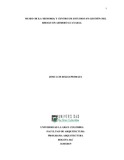Mostrar el registro sencillo del Documento
Museo de la memoria y centro de estudios en gestión del riesgo en Armero Guayabal
| dc.contributor.advisor | Marín Villegas, Juan Carlos | |
| dc.contributor.author | Rojas Pedraza, José Luis | |
| dc.date.accessioned | 2019-07-04T17:30:23Z | |
| dc.date.available | 2019-07-04T17:30:23Z | |
| dc.date.issued | 2019 | |
| dc.identifier.uri | http://hdl.handle.net/11396/5089 | |
| dc.description | La erupción del nevado del Ruiz el 13 de noviembre de 1985, ocasiono la destrucción del pueblo de Armero- Tolima, desde entonces debido a el abandono, el vandalismo y la falta de apropiación por el lugar han hecho que la memoria histórica y colectiva se deteriore; haciendo pertinente un diseño arquitectónico que permita rendir homenaje a la tragedia de Armero, buscando reducir la pérdida de memoria histórica y a su vez estructurar este diseño como un centro de estudio en la gestión del riesgo; para dar cumplimiento al objetivo del proyecto se llevó a cabo una recolección de datos históricos, topográficos y fotográficos con la ayuda de bases de datos, visitas y análisis del lugar. Como resultado, se diseñó un espacio museológico y científico que da solución a los problemas bioclimáticos del lugar sin dejar atrás el simbolismo que representa la tragedia logrando consolidarse como un espacio arquitectónico ejemplar de resiliencia en el país. | spa |
| dc.description.abstract | The eruption of the Ruiz snowcapped on November 13, 1985, caused the destruction of the town of Armero-Tolima, since then due to abandonment, vandalism and lack of appropriation by the place have caused the historical and collective memory to deteriorate ; making pertinent an architectural design that allows to pay homage to the tragedy of Armero, seeking to reduce the loss of historical memory and in turn structure this design as a center of study in risk management; To fulfill the objective of the project, a collection of historical, topographic and photographic data was carried out with the help of databases, visits and site analyzes. As a result, a museological and scientific space was designed to solve the bioclimatic problems of the place without leaving behind the symbolism that represents the tragedy, consolidating itself as an exemplary architectural space of resilience in the country. | spa |
| dc.language.iso | spa | |
| dc.publisher | Universidad La Gran Colombia | spa |
| dc.subject | Memoria colectiva | spa |
| dc.subject | Museología | spa |
| dc.subject | Identidad cultural | spa |
| dc.subject | Sentido de pertenencia | spa |
| dc.subject | Gestión de riesgos | spa |
| dc.subject | Resiliencia | spa |
| dc.title | Museo de la memoria y centro de estudios en gestión del riesgo en Armero Guayabal | spa |
| dc.subject.lemb | Resiliencia | spa |
| dc.subject.lemb | Administración de riesgos | spa |
| dc.subject.lemb | Museos históricos - Diseño - Armero (Tolima, Colombia) | spa |
| dc.subject.lemb | Identidad cultural | spa |
| dc.publisher.department | Arquitectura | spa |
| dc.publisher.program | Arquitectura | spa |
| dc.subject.keyword | Collective memory | spa |
| dc.subject.keyword | Museology | spa |
| dc.subject.keyword | Cultural identity | spa |
| dc.subject.keyword | Risk management | spa |
| dc.publisher.branch | Bogotá | spa |
| dc.creator.degree | Arquitecto(a) | spa |
Ficheros en el Documento
Este Documento aparece en la(s) siguiente(s) colección(ones)
-
Arquitectura [1096]


































